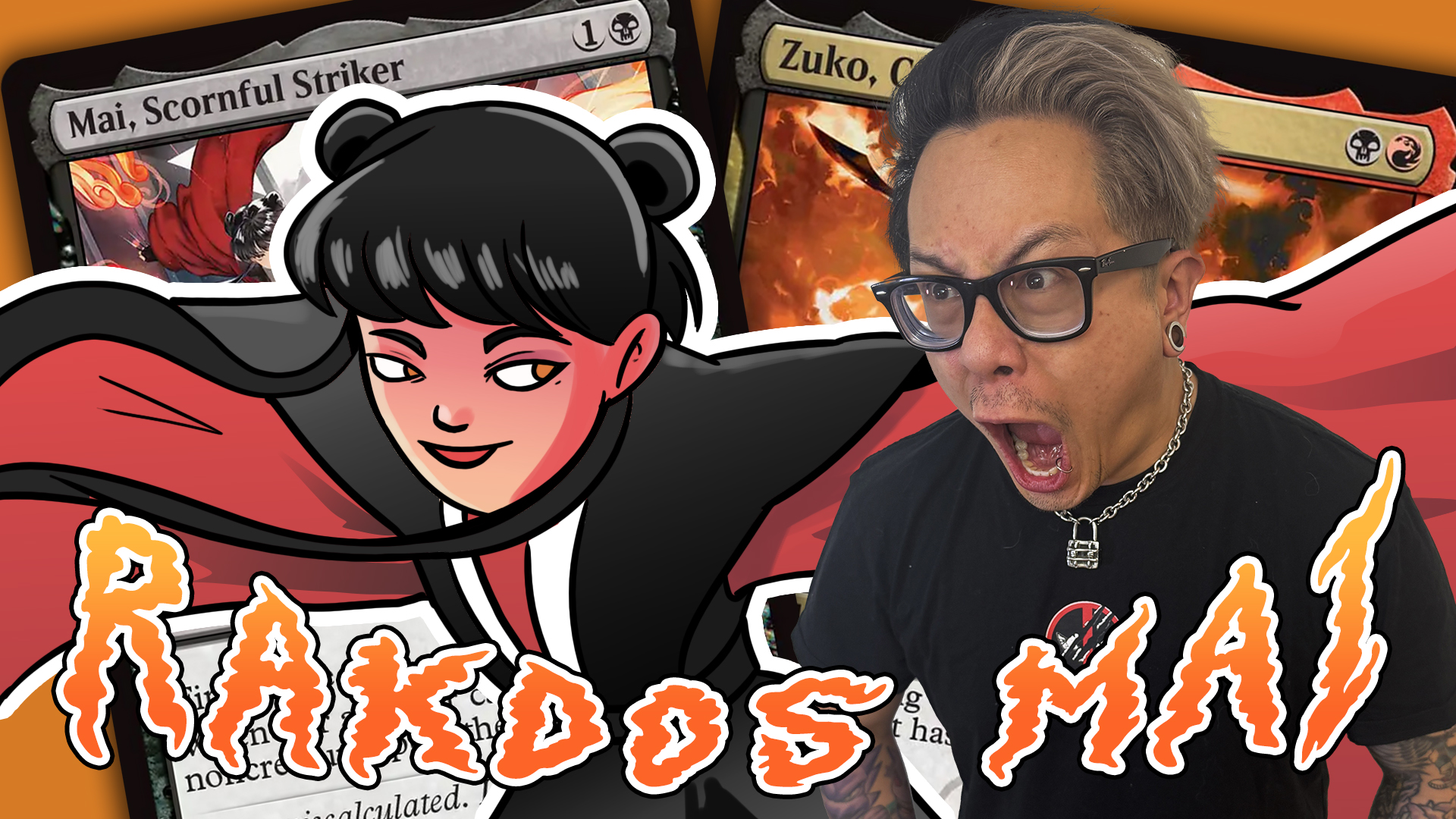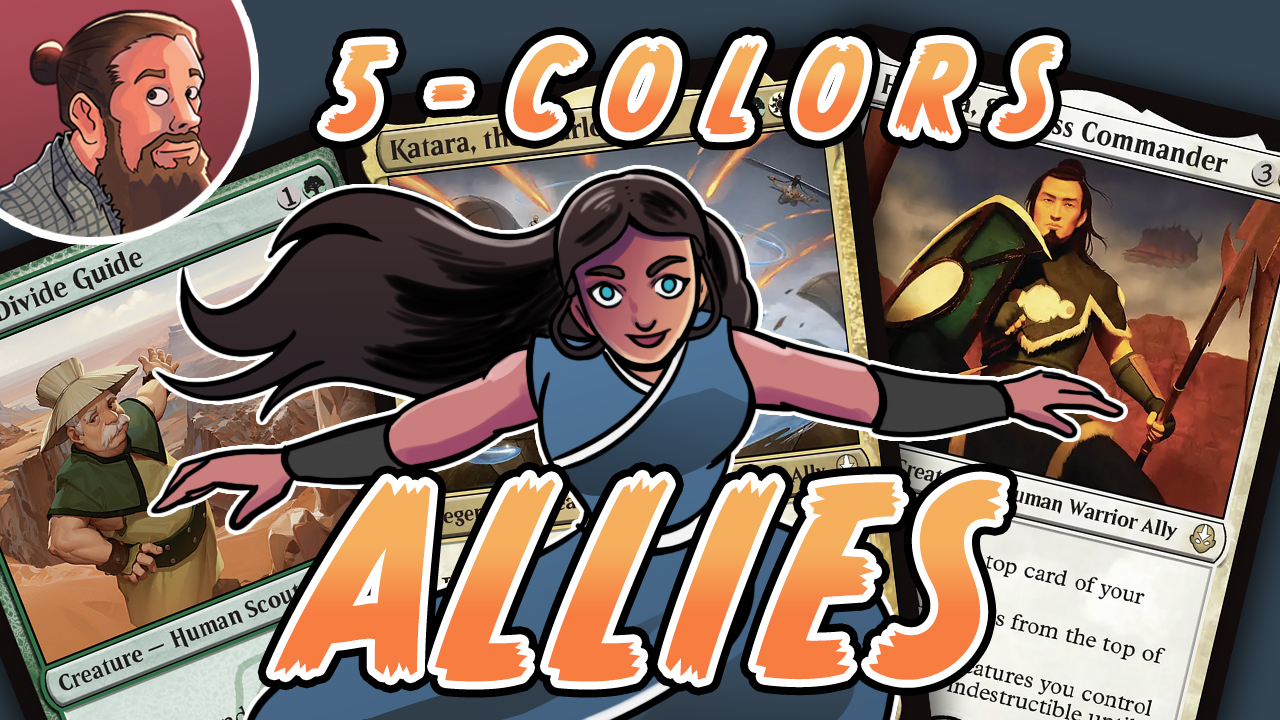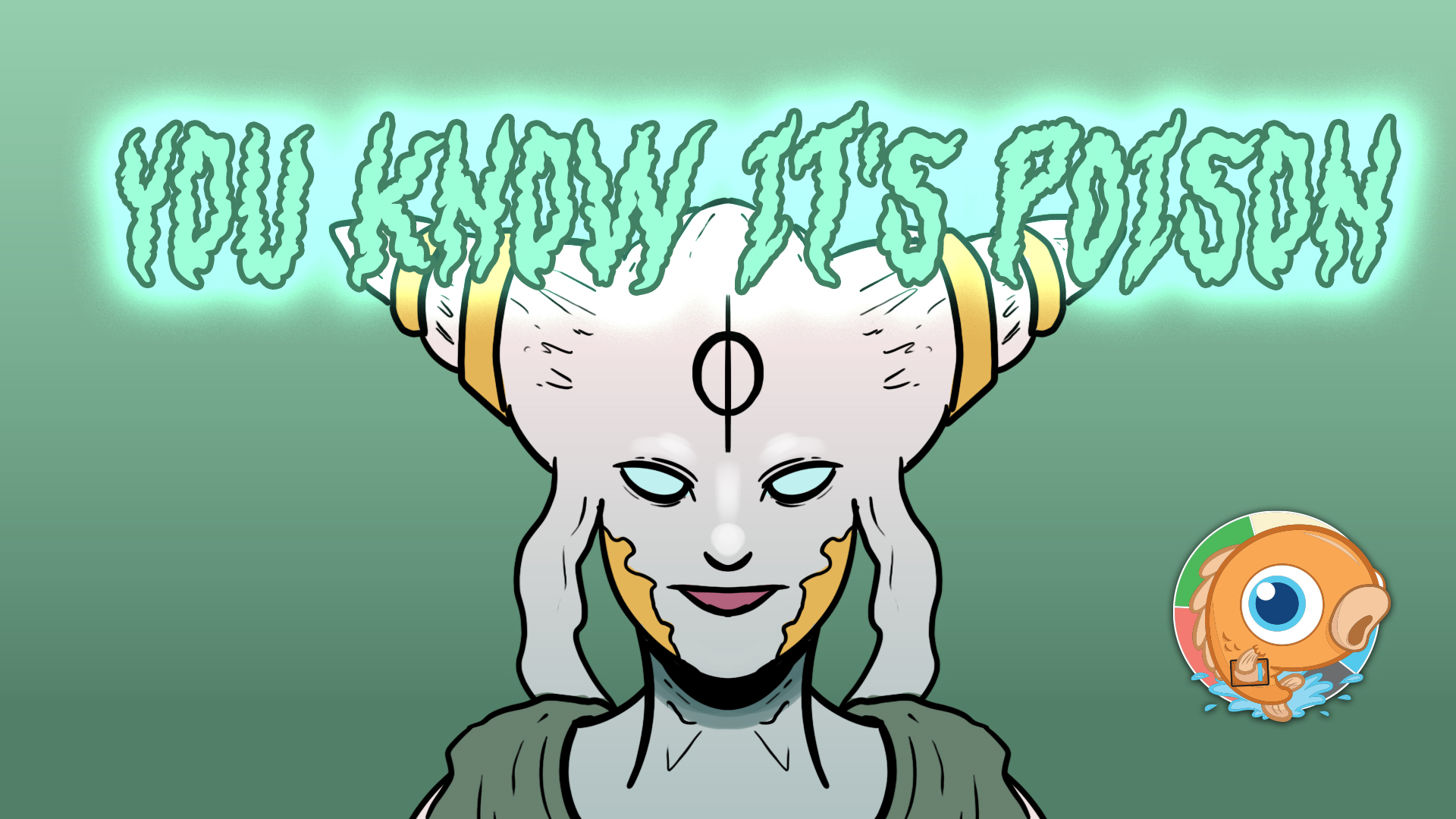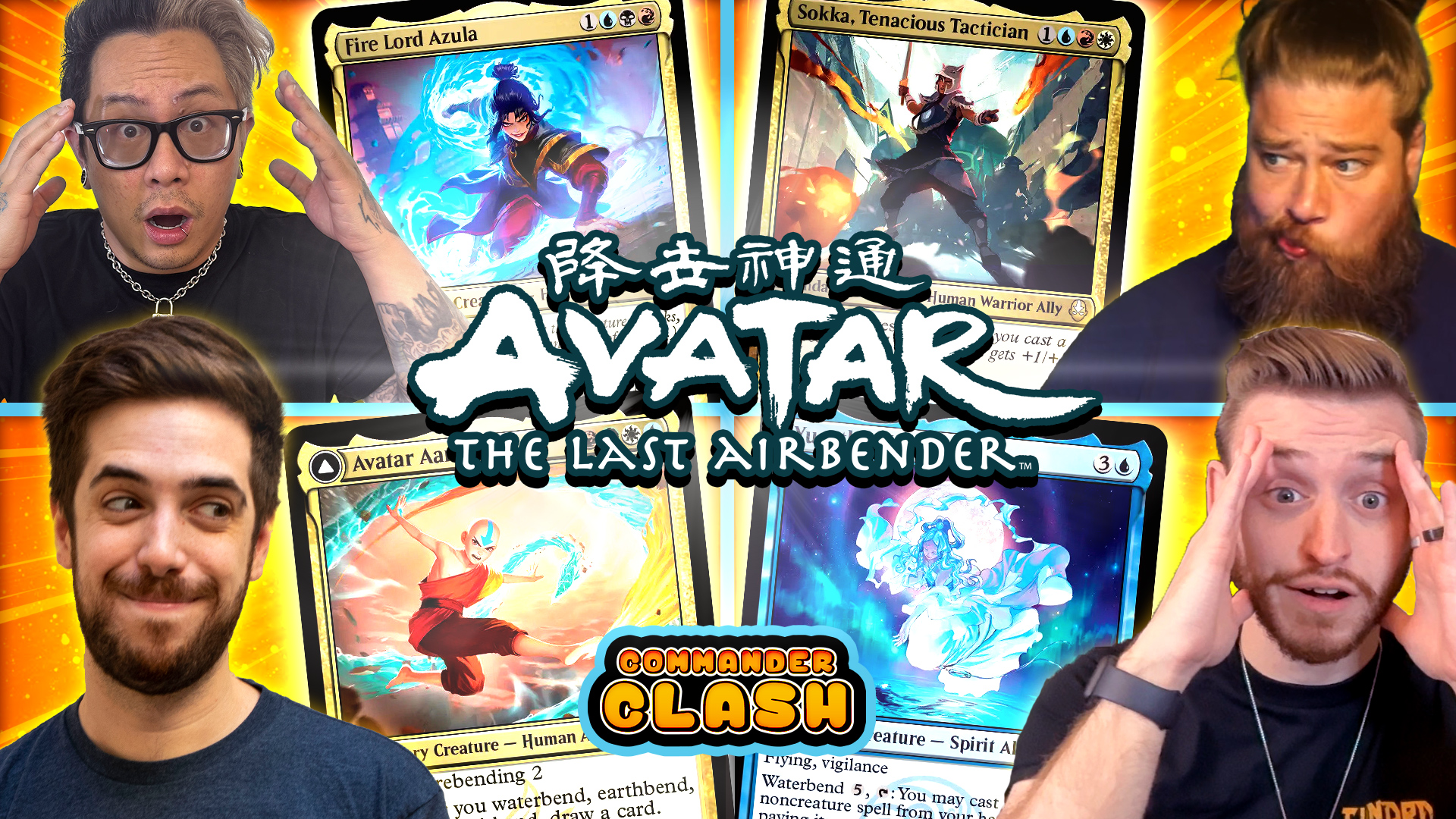How Many Legends Does it Take to Change a Lightbulb?
With the entirety of Dragons of Tarkir spoiled, it's clear that one of the defining characteristics of the set, besides dragons, is legendary creatures. In fact, Dragons of Tarkir alone has more legends than some recent blocks. I naturally tend to be skeptical of legends both as a financier and a player. As a player, even with the new legend rule, drawing multiples of a legendary creature is pretty close to a mulligan. As a financier, most of the Standard-only cards that see significant price increases see play as four-ofs. So, my gut instinct is to assume that most of the Dragons of Tarkir legends will be lacking in play and in price.
However, I'm not one to go on my gut. Thankfully there have been a significant number of legends printed over the past few blocks. Instead of just guessing at how much play the Elder Dragons and Khans will see, we can look back at other cards with the same restriction and analyze just how much they impacted their respective Standard formats. Here are the questions we are looking to answer today.
- Did the card see meaningful play in Standard. If yes,
- How many copies did people typically run in their decks?
- Does the converted mana cost of a legend make a difference (i.e. is a two-drop legend more or less likely to be an four-of than a five-drop legend).
- Finally, assuming some legends do see four-of play, why? What are the characteristics of a four-of legend?
To answer these questions we will be moving back through the past few blocks and breaking down the legends they contained based on the above criteria. Before we get to it, one more note: all the decklists I'm using for this research are from competitive or professional level events. This includes things like Grand Prixes, SCG Opens, Pro Tours, and States/Nationals. So if I say a legend didn't see any play, this doesn't mean that no one has ever played the card, rather, the card hasn't seen play at the highest levels of competitive magic. Since Fate Reforged is only a bit over a month old (which isn't really enough time to make definitive statements about levels of play), we'll start with Khans of Tarkir.
Khans of Tarkir
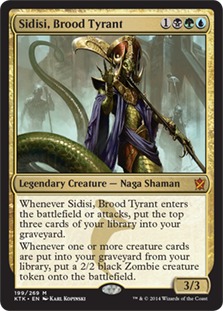


| Card | # of Decks | Average # | CMC | Dominance |
| Anafenza, the Foremost | 91 | 3.6 | 3 | 327.6 |
| Sidisi, Brood Tyrant | 33 | 4 | 4 | 132 |
| Narset, Enlightened Master | 5 | 1.2 | 6 | 6 |
| Sarruk Dragonclaw | 5 | 1.2 | 5 | 6 |
Unplayed KTK Block Legends: Zurgo Helmsmasher.
Of the five legends in Khans of Tarkir, two are almost universally adapted as four-ofs in their respective decks: Sidisi, Brood Tyrant in Sidisi Whip and Anafenza, the Foremost in Abzan. The other three legends are the definition of fringe cards — even when people are playing decks in their colors, they are most often left on the sidelines; when they are included, it is almost always only one copy.
Whether or not being legendary is what's holding back the latter three is up for debate. We know that expensive creatures have a high hurdle in breaking into constructed anyway, so it seems more likely that being legendary just raises the bar even higher. Sidisi, Brood Tyrant, on the other hand, not only has a lower converted mana cost, but also has a unique and powerful effect on the game. Anafenza, the Foremost seems to make up for being a legend with brute strength — being far and away the hardest hitting three-drop in Standard.
Theros Block
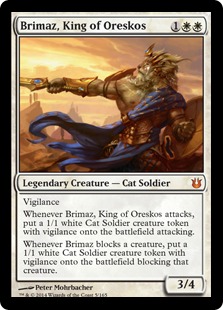


| Card | # of Decks | Average # | CMC | Dominance |
| Polukranos, World Eater | 307 | 3.1 | 4 | 951.7 |
| Brimaz, King of Oreskos | 146 | 2.7 | 3 | 394.2 |
| Tymaret, the Murder King | 3 | 2 | 2 | 6 |
Unplayed Legends: Anax and Cymede, Anthousa, Setessan Hero, Daxos of Meletis, Hythonia the Cruel, King Macar, the Gold-Cursed, Triad of Fates, and Tromokratis.
First off, I decided not to include any of the gods because they often play as indestructible legendary enchantments instead of creatures, which skews the numbers. Do any of use really think that if Thassa, God of the Sea was simply a creature with the same abilities she would cost 2U? The need for devotion is a significant drawback and allowed R&D to cheat on mana cost quite a bit.
The other 10 legends provide some interesting case-studies. It seems likely that the two most played legends, Polukranos, World Eater and Brimaz, King of Oreskos fall into the Anafenza camp of playable legends with a bit of Sidisi's uniqueness thrown in for good measure. Both are significantly above the curve, which seems to be a developing theme for legends that see play as three or four-ofs. For Polukranos, World Eater, you can even make a somewhat reasonable argument that being legendary is a benefit instead of a drawback, since you can intentionally legend-rule away a monstrous Polukranos, World Eater to get a fresh copy and Plague Wind your opponent's board a second time.
As for the long list of unplayed legends, I can see a strong argument that for Daxos of Meletis and Anax and Cymede in specific, being legendary is at least part of what's holding them back from seeing Standard play. Both have the right CMC and while neither is just so far above the curve that you just have to play them in your deck, both seem like the could have at least fringe applications in decks like heroic if drawing multiples wasn't so detrimental to the game plan.
Return to Ravnica Block



| Card | # of Decks | Average # | CMC | Dominance |
| Obzedat, Ghost Council | 193 | 2 | 5 | 396 |
| Aurelia, the Warleader | 43 | 2 | 6 | 86 |
| Varolz, the Scar-Stripped | 33 | 2.5 | 3 | 82.5 |
| Prime Speaker Zegana | 20 | 2 | 6 | 40 |
| Trostani, Selesnya's Voice | 18 | 2 | 4 | 36 |
| Borborgamos Enraged | 12 | 1.4 | 6 | 16.8 |
| Exava, Rakdos Bloodwitch | 5 | 3.1 | 4 | 15.5 |
| Jarad, Golgari Lich Lord | 4 | 1.8 | 4 | 7.2 |
| Niv-Mizzet, Dracogenius | 2 | 1.5 | 6 | 3 |
Unplayed RTR Block Legends: Borborygmos Enraged, Emmara Tandris, Isperia, Supreme Judge, Lavinia of the Tenth, Lazav, Dimir Mastermind, Melek, Izzet Paragon, Mirko Vosk, Mind Drinker, Rakdos, Lord of Riots, Tajic, Blade of the Legion, Teysa, Envoy of Ghosts, Vorel of the Hull Clade.
The legends from Return to Ravnica are the type of cards I generally associate with being legends. Most are big, have high converted mana costs, and are flavorful. Some of the most powerful ones see play in a lot of decks, but none of the cards (discounting the very fringe Exava, Rakdos Bloodwitch) can manage much more than being two-ofs. Cards like Obzedat, Ghost Council and Aurelia, the Warleader are both unique and significantly above the curve, but at five- and six-mana, you really can't run a full set. This is especially true of Obzedat, Ghost Council who is pretty difficult to kill; once you resolve a copy, it's relatively unlikely that you'll need another.
Of the expensive cards that did see significant play, Prime Speaker Zegana is a good example of a legend that still does something when you draw more than one. At worst, you can still turn the fresh copy into an Opportunity. In Dragons, the two most similar cards are Dragonlord Atarka and Sidisi, Undead Vizier, although it seems likely that Zegana is more powerful than the latter, if not the former as well.
As for the group of unplayed cards, it's hard to imagine their legendary status being the biggest problem. Most of them are some combination of overcosted and underpowered. Even without being legends, it's hard for me to imagine them seeing significant play. That said, some of the low-CMC mythics like Varolz, the Scar-Stripped, Jarad, Golgari Lich Lord, and Exava, Rakdos Bloodwitch maybe have seen a slight uptick in popularity if the were not legendary. These three cards provide a good example of how being legendary can hold a creature back in constructed. All three are, at least to some extent, "build around me" type cards; the type of cards that, if you put them in your deck, you really need to draw for your deck to function optimally. This means you likely want four in your deck. At the same time, if you have a starting hand with three Varolz, the Scar-Stripped, you're basically running on a mulligan to five (we'll talk more about the math later in the section on hypergeometric distribution). As a result, building around legends that are not blatantly overpowered (like Brimaz, King of Oreskos) or that somehow minimize their legendary drawback (Polukranos, World Eater and Prime Speaker Zengana) isn't usually worth the risk.
Innistrad Block
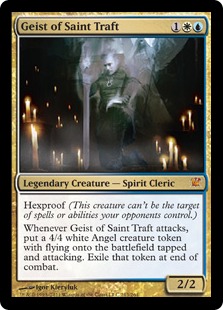


| Card | # of Decks | Average in Deck | CMC | Dominance |
| Geist of Saint Traft | 317 | 4 | 3 | 1268 |
| Thalia, Guardian of Thraben | 132 | 3 | 2 | 396 |
| Olivia Voldarin | 182 | 2.8 | 4 | 509.6 |
| Mikaeus, the Lunarch | 32 | 1.2 | 1 | 38.4 |
| Sigarda, Hosts of Herons | 18 | 1.4 | 5 | 25.2 |
| Griselbrand | 15 | 1.4 | 8 | 21 |
Unplayed Innistrad Legends: Avacyn, Angel of Hope, Bruna, Light of Alabaster, Gisela, Blade of Goldnight, Grimgrin, Corpse Born, Mikaeus, the Unhollowed.
Innistrad block gives us maybe the best comparison to the legends of Dragons of Tarkir with the angels of Avacyn Restored. But unfortunately for the dragons, very few of the angels saw meaningful play in Standard. This is despite the fact that, if you match up the dragons and angels side-by-side, the angels seem significantly more powerful. Compare, for example, Sigarda, Host of Herons with Dragonlord Dromoka. Which one seems better most games? Of course, this doesn't account for differences between formats, so perhaps Dragons of Tarkir Standard will be more accepting of huge but expensive fliers.
Geist of Saint Traft, on the other hand, sets the bar for legendary creatures seeing four-of play. It falls into the same category as Polukranos, World Eater and Brimaz, King of Oresko, but is even more powerful. The spirit is simply so good that you are willing to put up with the pseudo-mulligans that come with drawing multiples in your opening seven. It quickly became clear to everyone playing Innistrad Standard that you win more games mulliganing with four Geist of Saint Trafts in your deck than you do by avoiding the mulligan problem and running less Geists.
Thalia, Guardian of Thraben is another card that illustrates the downside of being legendary. In creature based decks, especially in a format full of Vapor Snag into Snapcaster Mage into Vapor Snag, Thalia, Guardian of Thraben has a huge impact on a game (and still does in Legacy). Her effect is one that, given the option, you would want on turn two every single game. However, if you look back through old decklists, you see that many players were only running three copies, and some only two. In fact, obviously inferior cards like Knight of Glory, Knight of Infamy, Precinct Captain, and Elite Inquisitor saw play over the fourth and sometimes third copies of Thalia, Guardian of Thraben. Thalia, Guardian of Thraben wasn't always a four-of was because she was legendary.
Putting it All Together
Between Innistrad and Khans of Tarkir, 46 different legendary creatures entered the multiverse — all were either rares or mythic rares. Of these 46 cards, 22 saw some amount of play in Standard, however only half of these saw what I would call significant play as characterized by a dominance score (the average number in decks x number of decks) of 40 or over. A grand total of five legends during this time period typically were played, on average, as at least three-ofs: Geist of Saint Traft, Thalia, Guardian of Thraben, Polukranos, World Eater, Anafenza, the Foremost, and Sidisi, Brood Tyrant.
What do these five cards have in common? Well, most obviously, all five of these cards have a CMC of four or less, which is often the cut-off for seeing significant competitive play in Standard. However, simply having the right CMC isn't enough, as there are plenty of legends from our unplayed list in this range. Second, these cards are either significantly above the curve, have a unique effect on the game, or in many cases both. As such, it seems that being cheap to cast and super-powerful is the criteria for a legendardy creature to see a lot of play. Who would have guessed?
The second and much larger group of legends — cards that see some amount of Standard play, but generally as one- or two-ofs in a smaller number of decks — have much looser converted mana costs requirements. They range from two-drops Mikaeus, the Lunarch to eight-drops like Griselbrand. However, it isn't simply CMC that separates these cards from the first group. In fact, the average CMC of this group is just 4.38, only slight more than the 3.9 for the most played group. Furthermore, many members of this group have unique effects. The problem is, most are simply on-curve, rather than above the curve.
So in evaluating legends, once you determine they are low-CMC (ideally four or less), unique, and on (or above) the curve, the most important question seems to be is this card so good that it's worth mulliganing to six in 20 percent of my games? If you actually look at the math, you'll see how important the difference between running two, three, or four copies actually is.
Hypergeometric Distribution
Hypergeometric distribution "applies to sampling without replacement from a finite population whose elements can be classified into two mutually exclusive categories like Pass/Fail, Female/Male or Employed/Unemployed." In Magic, this allows us to determine the odds of drawing a specific card in our opening hand, or on any subsequent turn of the game. For our purposes, we can use it to illustrate the risks and potential rewards for playing various numbers of a legendary creature in our decks.
For example, say you are playing a deck with four Geist of Saint Trafts. There is a 44.5 percent chance of having one in your opening seven and a 52.8 percent chance you have one by turn three. So, in more games than not, you'll have your turn three Geist of Saint Traft. The problem is, there is also a 12.6 percent chance you'll have a second (presumably dead) Geist of Saint Traft by turn three, and assuming the game goes on for seven or eight turns, you end up drawing a second Geist of Saint Traft one out of every four games.
Supposed you are playing a deck with three Thalia, Guardian of Thrabens. The odds of having a Thalia in your opening hand only drops 10 percent from the four-of percentage to 35.4 percent. So where you would have a Geist of Saint Traft in your opener once every 2.24 games (running four copies), Thalia, Guardian of Thraben will only be there once every 2.82 with three copies. But at the same time, your odds of drawing a second dead copy in the first three turns is nearly cut in half, from 12.6 percent to 6.9 percent. Better yet, your games would have to go to13 turns for you to have a one-in-four chance of drawing the second Thalia. If you cut the numbers even further and play only two copies of a legend, you'll only have a one-in-four chance of having it in your opener, but your odds of drawing a second copy are slim-to-none. Plus, as a two-of, your chances of drawing one of your two copies by turn eight is still a respectable 40 percent. So with a card like Pearl Lake Ancient or Dragonlord Atakra, you will still be able to cast it on time in nearly half of your games.
What Does This Mean for Dragons of Tarkir Legends?






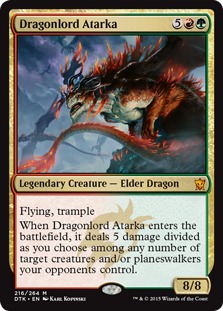


Let's start with the Elder Dragons because there isn't really much to say. There hasn't been a single legend in the past five years with a converted mana cost of five or more that saw significant Standard play. Not a single one. As such, I believe the absolute best case scenario for this cycle is to be like Sigarda, Host of Herons or Aurelia, the Warleader — cards that saw two-of play in a reasonable number of decks. On the other hand, the worst case scenario is ending up on the long list of high-CMC legends that saw zero competitive play. So what does this look like price wise?
Elder Dragons - Best Case
Elder Dragons - Worst Case
As for the rest of the Dragons of Tarkir legends, it's hard to see any falling into the Geist of Saint Traft/Polukranos World Eater group. Plus rare legends have much longer odds of making it into Standard than mythics. Sidisi, Undead Vizior might have a chance: her ability is unique, she does more than most legends when drawn is multiples, and her body is above the curve. These are three of the characteristics of heavily played legends. Unfortunately she fails the CMC test. I would expect that costing five is enough to keep the zombie from seeing four-of play. Falling in the 1.5-of or 2-of range with cards like Trostani, Selesnya's Voice seems most likely.
Zurgo Bellstriker has a pretty easy comparison in Isamaru, Hound of Konda as a one-CMC legendary 2/2. The hound might be a slightly better card simply because it can chump block a fatty in the late game, but Zurgo Bellstriker can come down with haste as necessary and red is likely the best aggro color in the current Standard. Finding decklists from 2006 isn't easy, but the few I've seen suggests Isamaru, Hound of Konda was most typically played as a three-of (which makes the most sense, given the math we were just discussing). This is what I would expect for Zurgo Bellstriker as well. He will definitely see play, but decks like mono-red can't afford to mulligan too often, so being a 4-of is likely off the table for the little guy. As such, I see another Firedrinker Satyr rather than another Goblin Guide.
Anafenza, Kin-Tree Spirit and Surrak, the Hunt Caller, at least for me, are the least exciting Standard cards in the bunch. A 5/4 for four with (maybe) haste just seems so much worse than Siege Rhino or Polukranos World Eater. I guess he could be considered on-curve, but being on-curve isn't enough to make a legendary playable, or to help it maintain a significant price tag. Anafenza, Kin-Tree Spirit is fine I guess, but it doesn't strike me as a Thalia, Guardian of Thraben type card that can just auto-win specific matchups on its own. Costing WW rather than 1W is a significant downside. I would expect these cards, at their best, to fall into the one-of category, which for low-CMC creatures pretty much says, "I don't have any better options and they make me play 60 cards, so I guess I can run one of these." At worst, they join the forgotten heroes group — the 52 percent of legendary creatures that don't see any Standard play at all.
Conclusion
Anyway, that's all for today. What do you make of this data? Can you think of any other legends that were so good you just had to jam four in your deck, legend rule be damned? Are any of the Dragons of Tarkir legends powerful enough to overcome history and be significant players in Standard? Let me know in the comments, or on Twitter @SaffronOlive.


